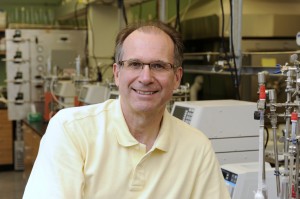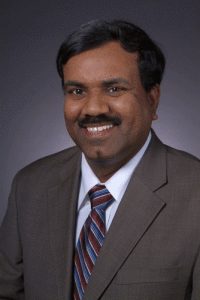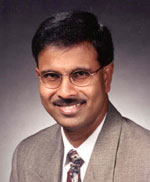Interdisciplinary teams working on the Dean’s Research Initiatives (DRIs) presented their progress to date in an open forum held May 15. The DRIs, established by the College of Engineering in 2011, awarded $500,000 to three teams to help them pursue larger funding opportunities.
Creating a carbon-negative economy

The Initiative for a Carbon Negative Economy (ICNE) is looking beyond reducing greenhouse gases to develop strategies that remove carbon dioxide from the atmosphere. The team is led by Robert Brown, Anson Marston Distinguished Professor of Engineering, Gary and Donna Hoover Chair in Mechanical Engineering, Iowa Farm Bureau director of the Bioeconomy Institute, director of the Center for Sustainable Environmental Technologies, and professor of mechanical engineering, chemical and biological engineering, and agricultural and biosystems engineering.
Brown is currently investigating the viability of biomass pyrolysis, which creates three byproducts—biochar, bio-oil, and a gas—and sequesters more carbon in the biochar than it produces. His research includes testing the ramifications of placing the biochar into soil, which ultimately returns carbon dioxide to the earth.
“We are modeling our approach after a man-made phenomena in the Amazon Basin called terra preta, or dark earth, which was developed by pre-Columbian societies,” Brown explains. “The charred biomass put into the ground has shown potential to be twice as productive as the surrounding oxisols.”
Brown and his colleagues have submitted several large proposals to broaden the ideas behind ICNE, including one to the Biomass Research and Development Initiative (BRDI), a joint program of the U.S. Departments of Agriculture (USDA) and Energy (DOE), and another to the Advanced Research Projects Agency-Energy (ARPA-E).
ICNE has also been forming partnerships with similarly focused organizations to develop stronger proposals. Recent partners include the Science Applications International Corporation (SAIC), which is researching methods to help lower the carbon footprints of U.S. armed forces, and the University of Dayton.
“There is a solicitation out for renewable energy and environmental technology from the U.S. Air Force, and Dayton has asked us to be one of the providers of technology for this application,” Brown said. “We hope this will be a good foot in the door for us with the Air Force.”
Solving biology’s data-intensive problems

Led by Srinivas Aluru, Ross Martin Mehl and Marylyne Munas Mehl Professor of Computer Engineering, the High Throughput Computational Biology Initiative is tackling the need for more data analysis brought about by high throughput instrumentation. The team’s research is addressing microbial applications, such as biothreat detection, along with plant applications for agricultural biotechnology and bioenergy.
The group has chosen three key focus areas—next-generation sequencing, systems biology, and its newest endeavor, phenomics (the measurement of the physical and biochemical traits of organisms as they change due to mutation or environmental impacts). “I look at phenomics as a start-up activity, so we’re building up capabilities in this area to help us prepare to compete for large proposals,” Aluru said.
Proposals submitted by the group have been focused mainly on next-generation sequencing and systems biology research, including a successful $1 million award from the National Science Foundation (NSF) for a parallel genome assembly proposal.
Aluru and his team have also submitted proposals in the areas of large-scale biological and social network analysis, and multiscale metabolic engineering for hydrocarbon production.
The group has also been successful in creating collaborations with other companies and universities. Team members are currently in the process of a partnership with the prominent accelerator computing technology company Nvidia, and recently started working with Micron, a leading manufacturer of semiconductor systems.
“We are one of two or three groups Micron is providing funding to explore the use of a new chip they are developing in specific domains. The company wants us to explore whether its chip can be used to solve problems in biology. All of the research will remain confidential until next June,” said Aluru.
Reaching 20 percent wind by 2030

Building off the DOE scenerio to achieve 20 percent energy by wind in the U.S. by 2030, the Wind Energy Initiative (WEI) has developed both educational and research programs to support wind energy growth.
“Iowa has already achieved that 20 percent, so our job now is to help others reach that goal in the next 20 years,” said Sri Sritharan, WEI lead, Wilson Engineering Professor and professor of civil, construction, and environmental engineering.
The past year has included several exciting developments in wind energy educational opportunities at Iowa State:
- Development of a new wind energy minor
- Research Experience for Undergraduates (REU) program in Wind Energy Science, Engineering and Policy (WESEP)—$400,000 (NSF)
- PhD program in WESEP (the nation’s first)—$3.2 million NSF Integrative Graduate Education and Research Traineeship (IGERT) award
WEI has also persued a variety of grants for its research thrusts, including:
- Wind Turbine Icing Physics and Anti-/De-icing Technology—$1.3 million (NSF/NASA)
- Advanced Manufacturing Innovation Initiative (AMII) —$1 million (DOE)
- Tall Wind Turbine Towers (100+ meters) —$200,000 (various sponsors)
- Lignin-based Carbon Fibers for Wind Turbine Blades—$1.2 million (DOE – pending)
The group’s initial successes have been noticed across the nation – WEI is having trouble managing all the incoming requests for partnerships from companies and organizations.
Sritharan said the future of WEI will include creating an American Wind Energy Association (AWEA) student chapter, for which Iowa State was hand picked; hosting workshops to increase program funding; and continuing collaborations with universities and national labs. He said the ultimate goal will be to establish a Center for Wind Energy at Iowa State.
